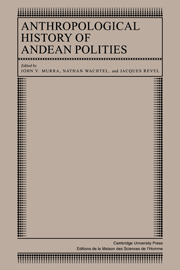Book contents
- Frontmatter
- Contents
- List of contributors
- Preface
- Introduction
- Part I Ecology and society
- Part II The ethnic group and the state
- Part III Systems of classification
- 8 Some aspects of the Inka kinship system
- 9 The classification and naming of South American camelids
- 10 The semiology of Andean textiles: the talegas of Isluga
- Part IV Symbolic representations and practices
- Part V From ethnic polities to communities
- Bibliography of published source
- Index
9 - The classification and naming of South American camelids
Published online by Cambridge University Press: 05 October 2010
- Frontmatter
- Contents
- List of contributors
- Preface
- Introduction
- Part I Ecology and society
- Part II The ethnic group and the state
- Part III Systems of classification
- 8 Some aspects of the Inka kinship system
- 9 The classification and naming of South American camelids
- 10 The semiology of Andean textiles: the talegas of Isluga
- Part IV Symbolic representations and practices
- Part V From ethnic polities to communities
- Bibliography of published source
- Index
Summary
In conversation with a herder from the Andean altiplano, I asked if he would be able to recognize any one of his alpacas and llamas wherever he saw them. He said he would, and when I pressed him as to his method, he asked, “Can you recognize your children when you see them, even far from home?” I said, “yes, but I haven't got three hundred children.” “So what?” he said. “The alpacas are like children to us, we recognize them everywhere. We know them, and we love each one from the day they're born.”
The herder's answer made sense. It showed the same high level of understanding between men, alpacas, and llamas that appears in ceremonials and myths (Flores 1976). There is, however, still a question about the techniques that enable them to distinguish each single animal in the herd and recognize it at any time or place, and, especially, about how they then transmit this information to other herders so that they can do the same. What follows here deals with the system of describing llamas and alpacas, although it is only a partial treatment. The folk taxonomy is part of the techniques and practice of herding; it has its own special language, which helps and perpetuates this economic activity.
It is rare for herders to baptize their alpacas or llamas with proper names. Among the exceptions are animals born on certain days, thought to be special. Those born on January 6, the Feast of the Epiphany, are called Revis; those born on January 20, which commemorates Saint Sebastian, are called Sebastian. Some of those born on a Sunday are called Domingo.
- Type
- Chapter
- Information
- Anthropological History of Andean Polities , pp. 137 - 148Publisher: Cambridge University PressPrint publication year: 1986
- 1
- Cited by



